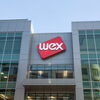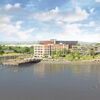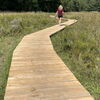Saving on energy costs, one gelato flavor at a time
 Photo / James McCarthy
Fred Horch, co-owner of Spark Applied Efficiency, stands next to a 'solar wall' his company recommended for a south-facing wall at the Wicked Joe coffee roasting plant in Topsham. The solar wall is designed to help reduce heating costs.
Photo / James McCarthy
Fred Horch, co-owner of Spark Applied Efficiency, stands next to a 'solar wall' his company recommended for a south-facing wall at the Wicked Joe coffee roasting plant in Topsham. The solar wall is designed to help reduce heating costs.
Fred Horch and Pat Coon, co-founders of Spark Applied Efficiency, have been helping Gelato Fiasco make a lot more gelato in its expanded “flavor foundry” in Brunswick while using a lot less energy and water.
Horch and Coon launched their company in 2014 to help businesses create more value through smarter energy efficiency. Horch previously owned a store on Maine Street in Brunswick called F.W. Horch Sustainable Business Supplies, which focused on retail sales. He also was the coordinator for Maine Inter-Faith Power & Light, which rolled out the first 'green electricity' offering in Maine. Coon co-founded ReVision Energy, the largest solar installer in Maine, and went on to found ReVision Heat, which focuses on energy efficient heating systems including wood and pellet boilers.
Clients have included restaurants, grocers and food-processing facilities. As an Efficiency Maine-qualified partner, Spark leverages state rebate funds to conserve resources, prevent pollution, create jobs and help grow Maine's economy in a sustainable way. Services include energy modeling, cash flow analysis and the installation of LED lighting, demand control and energy recovery ventilation, refrigeration, HVAC, heat pumps, electric vehicle charging stations and solar photovoltaic systems.
Mainebiz recently met with Horch at Gelato Fiasco. An edited transcript follows.
Mainebiz: Tell us about the work you've done at Gelato Fiasco's newly expanded production plant.
Fred Horch: Making gelato removes heat from milk. In a conventional gelato facility, this heat is simply wasted. But Spark is helping Gelato Fiasco harness waste heat for hot water, space heating and snow melting, thanks to a smart energy recovery system. Once the flavor foundry is up and running, Spark's efficient heat recovery system is projected to conserve 1.89 million gallons of water per year compared to an open loop water-cooled system. Using waste heat for space heating and water heating will allow Gelato Fiasco to avoid burning 337,938 cubic feet of natural gas each year, preventing almost 20 tons of carbon dioxide pollution annually in Brunswick.
MB: What role did Efficiency Maine play in this project?
FH: A key factor in the deployment of the system was receiving pre-approval from Efficiency Maine's custom incentive program, which provides rebates for investments in efficiency that deliver significant and cost-effective energy savings. Over the life of the system, operating cost savings will more than pay for the additional one-time capital cost.
MB: Did you have to create the system from scratch?
FH: Two key elements of the energy-recovery system we designed are the heat pumps from manufacturer Nyle Systems in Brewer and a customized control system developed by the engineering firm Innovative Automation Solutions of South Portland. Rather than heat being dumped down the drain as in an open-loop water cooling system, or lost to the outdoor air as with a conventional air-cooled refrigeration system, our system makes beneficial use of waste heat using a set of closed loops around Gelato Fiasco's facility.
The 'brain' of the Spark energy-recovery system is constantly monitoring the temperature of the fluids circulating through the gelato-making equipment, and of fluids circulating through hot water tanks and slabs under the building and the parking lot. Heat removed from the gelato is pumped into hot water for hand- or dish-washing, or into the slab under the building for space heating, or into the slab under the parking lot for snow melting. If no beneficial use is available for the heat from the gelato-making process, then the system sends excess heat to outdoor air, or to an open loop water dump in an emergency.
MB: What kind of savings might businesses see by investing in energy efficiency?
FH: What we like to get to is the annual yield on your investment. That's really what you're looking for. So, if you had $100 to invest in your business, how much are you going to make per year? We're always looking at trying to get people a 10% to 12% return on investment, and that's after taxes. And that ROI is not subject to sales; it's from reducing your operating costs. It's a number you can count on.










Comments